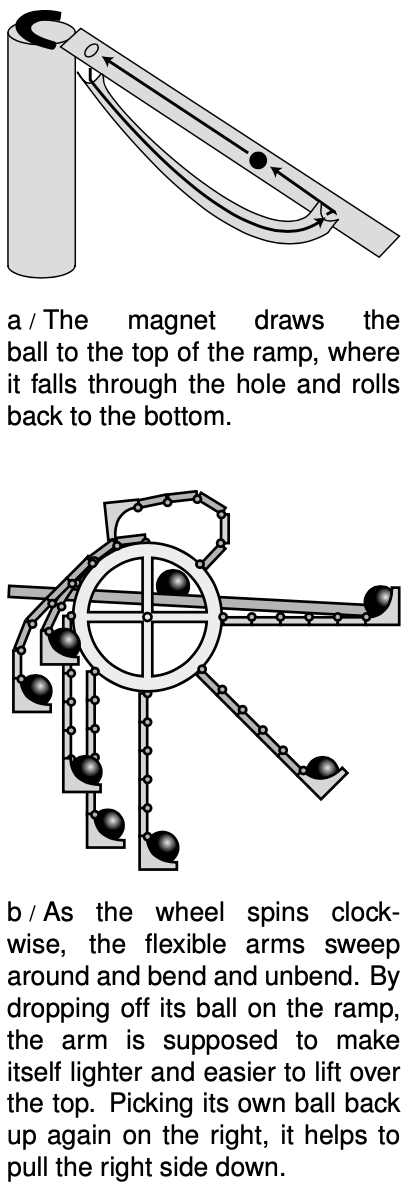11.1 The search for a perpetual motion machine by Benjamin Crowell, Light and Matter licensed under the Creative Commons Attribution-ShareAlike license.
11.1 The search for a perpetual motion machine
Don't underestimate greed and laziness as forces for progress. Modern chemistry was born from the collision of lust for gold with distaste for the hard work of finding it and digging it up. Failed efforts by generations of alchemists to turn lead into gold led finally to the conclusion that it could not be done: certain substances, the chemical elements, are fundamental, and chemical reactions can neither increase nor decrease the amount of an element such as gold.
Now flash forward to the early industrial age. Greed and laziness have created the factory, the train, and the ocean liner, but in each of these is a boiler room where someone gets sweaty shoveling the coal to fuel the steam engine. Generations of inventors have tried to create a machine, called a perpetual motion machine, that would run forever without fuel. Such a machine is not forbidden by Newton's laws of motion, which are built around the concepts of force and inertia. Force is free, and can be multiplied indefinitely with pulleys, gears, or levers. The principle of inertia seems even to encourage the belief that a cleverly constructed machine might not ever run down.
have tried to create a machine, called a perpetual motion machine, that would run forever without fuel. Such a machine is not forbidden by Newton's laws of motion, which are built around the concepts of force and inertia. Force is free, and can be multiplied indefinitely with pulleys, gears, or levers. The principle of inertia seems even to encourage the belief that a cleverly constructed machine might not ever run down.
Figures a and b show two of the innumerable perpetual motion machines that have been proposed. The reason these two examples don't work is not much different from the reason all the others have failed. Consider machine a. Even if we assume that a properly shaped ramp would keep the ball rolling smoothly through each cycle, friction would always be at work. The designer imagined that the machine would repeat the same motion over and over again, so that every time it reached a given point its speed would be exactly the same as the last time. But because of friction, the speed would actually be reduced a little with each cycle, until finally the ball would no longer be able to make it over the top.
Friction has a way of creeping into all moving systems. The rotating earth might seem like a perfect perpetual motion machine, since it is isolated in the vacuum of outer space with nothing to exert frictional forces on it. But in fact our planet's rotation has slowed drastically since it first formed, and the earth continues to slow its rotation, making today just a little longer than yesterday. The very subtle source of friction is the tides. The moon's gravity raises bulges in the earth's oceans, and as the earth rotates the bulges progress around the planet. Where the bulges encounter land, there is friction, which slows the earth's rotation very gradually.
11.1 The search for a perpetual motion machine by Benjamin Crowell, Light and Matter licensed under the Creative Commons Attribution-ShareAlike license.